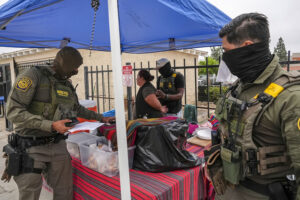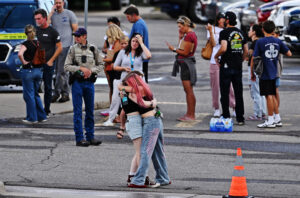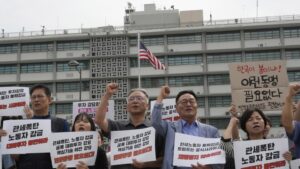The Dictatorship
Palestinians fear a repeat of their 1948 mass expulsion in the wake of Trump’s remarks on Gaza

JERUSALEM (AP) — Palestinians will mark this year the 77th anniversary of their mass expulsion from what is now Israelan event that is at the core of their national struggle.
But in many ways, that experience pales in comparison to the calamity now faced in the Gaza Strip — particularly as President Donald Trump has suggested that displaced Palestinians in Gaza be permanently resettled outside the war-torn territory and that the United States take “ownership” of the enclave.
Palestinians refer to their 1948 expulsion as the Nakba, Arabic for catastrophe. Some 700,000 Palestinians — a majority of the prewar population — fled or were driven from their homes before and during the 1948 Arab-Israeli war that followed Israel’s establishment.
After the war, Israel refused to allow them to return because it would have resulted in a Palestinian majority within its borders. Instead, they became a seemingly permanent refugee community that now numbers some 6 million, with most living in slum-like urban refugee camps in Lebanon, Syria, Jordan and the Israeli-occupied West Bank.
In Gaza, the refugees and their descendants make up around three-quarters of the population.
Israel’s rejection of what Palestinians say is their right of return to their 1948 homes has been a core grievance in the conflict and was one of the thorniest issues in peace talks that last collapsed 15 years ago. The refugee camps have always been the main bastions of Palestinian militancy.
Now, many Palestinians fear a repeat of their painful history on an even more cataclysmic scale.
All across Gaza, Palestinians in recent days have been loading up cars and donkey carts or setting out on foot to visit their destroyed homes after a ceasefire in the Israel-Hamas war took hold Jan. 19. The images from several rounds of mass evacuations throughout the war — and their march back north on foot — are strikingly similar to black-and-white photographs from 1948.
Mustafa al-Gazzar, in his 80s, recalled in 2024 his family’s monthslong flight from their village in what is now central Israel to the southern city of Rafah, when he was 5. At one point they were bombed from the air, at another, they dug holes under a tree to sleep in for warmth.
Al-Gazzar, now a great-grandfather, was forced to flee again in the war, this time to a tent in Muwasi, a barren coastal area where some 450,000 Palestinians live in a squalid camp. He said then the conditions are worse than in 1948, when the U.N. agency for Palestinian refugees was able to regularly provide food and other essentials.
“My hope in 1948 was to return, but my hope today is to survive,” he said.
The war in Gaza, which was triggered by Hamas’ Oct. 7 attack into Israel, has killed over 47,000 Palestinians, according to local health officials, making it by far the deadliest round of fighting in the history of the conflict. The initial Hamas attack killed some 1,200 Israelis.
The war has forced some 1.7 million Palestinians — around three quarters of the territory’s population — to flee their homes, often multiple times. That is well over twice the number that fled before and during the 1948 war.
Israel has sealed its border. Egypt has only allowed a small number of Palestinians to leave, in part because it fears a mass influx of Palestinians could generate another long-term refugee crisis.
The international community is strongly opposed to any mass expulsion of Palestinians from Gaza — an idea embraced by far-right members of the Israeli government, who refer to it as “voluntary emigration.”
Israel has long called for the refugees of 1948 to be absorbed into host countries, saying that calls for their return are unrealistic and would endanger its existence as a Jewish-majority state. It points to the hundreds of thousands of Jews who came to Israel from Arab countries during the turmoil following its establishment, though few of them want to return.
Even if Palestinians are not expelled from Gaza en masse, many fear that they will never be able to return to their homes or that the destruction wreaked on the territory will make it impossible to live there. One U.N. estimate said it would take until 2040 to rebuild destroyed homes.
The Jewish militias in the 1948 war with the armies of neighboring Arab nations were mainly armed with lighter weapons like rifles, machine guns and mortars. Hundreds of depopulated Palestinian villages were demolished after the war, while Israelis moved into Palestinian homes in Jerusalem, Jaffa and other cities.
In Gaza, Israel has unleashed one of the deadliest and most destructive military campaigns in recent history, at times dropping 2,000-pound (900-kilogram) bombs on dense, residential areas. Entire neighborhoods have been reduced to wastelands of rubble and plowed-up roads, many littered with unexploded bombs.
Yara Asi, a Palestinian assistant professor at the University of Central Florida who has done research on the damage to civilian infrastructure in the war, says it’s “extremely difficult” to imagine the kind of international effort that would be necessary to rebuild Gaza.
Even before the war, many Palestinians spoke of an ongoing Nakba, in which Israel gradually forces them out of Gaza, the West Bank and east Jerusalem, territories it captured during the 1967 war that the Palestinians want for a future state. They point to home demolitions, settlement construction and other discriminatory policies that long predate the war, and which major rights groups say amount to apartheidallegations Israel denies.
Asi and others fear that if another genuine Nakba occurs, it will be in the form of a gradual departure.
“It won’t be called forcible displacement in some cases. It will be called emigration, it will be called something else,” Asi said.
“But in essence, it is people who wish to stay, who have done everything in their power to stay for generations in impossible conditions, finally reaching a point where life is just not livable.”
___
Associated Press reporters Wafaa Shurafa and Mohammad Jahjouh in Rafah, Gaza Strip, contributed to this report.
___
The Associated Press is republishing this story from May 14, 2024, to update with the ceasefire and President Donald Trump’s comments about the Gaza Strip.
The Dictatorship
Charlie Kirk’s death leaves lawmakers on edge across party lines
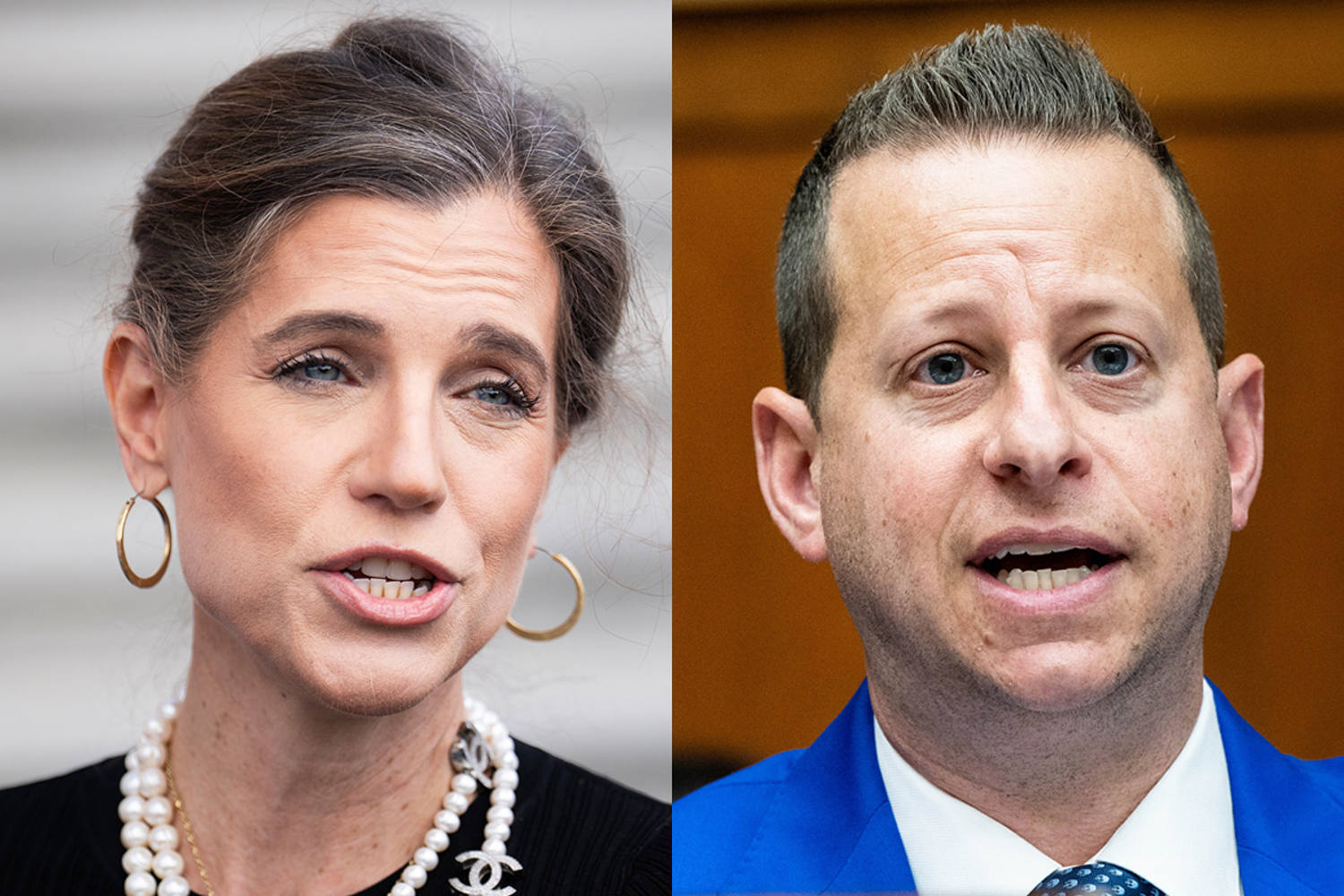
Lawmakers are on high alert after the assassination of conservative activist Charlie Kirkvoicing concerns about their safety and making calls for increased protection as the political atmosphere in the U.S. grows more tense.
Fears have been aired on both sides of the aisle. Democrats and Republicans, many of whom maintained a close relationship with Kirk, say they’re worried about their own security and that of their families, staffers and colleagues.
Some members of Congress are taking immediate action.
Rep. Alexandria Ocasio-Cortez, D-N.Y., is postponing two upcoming events in North Carolina, according to her office. Democratic Rep. James Clyburn, D-S.C., canceled events this weekend, though he asked his staff that a church service remain on the schedule. And Reps. Jared Moskowitz, D-Fla., and Nancy Mace, R-S.C., told BLN they are pausing public events in the near term.
Moskowitz — who was targeted last year by an armed man who has been sentenced to 25 years in federal prison for illegal firearms offenses — said he is concerned about the safety of the entire House of Representatives.
‘We all go to things like that. We all speak at colleges, we all go to public events, we all do parades. That could’ve been anybody.’
“I’m worried about everybody in that chamber, including myself,” Moskowitz said. “I’m worried about my Republican colleagues that are vocal on TV and social media; I’m worried about my Democratic colleagues who are vocal on TV and social media.”
He called the shooting death of Kirk, video footage of which quickly went viral, “shocking and terrifying and dehumanizing” and said it hits close to home for politicians who routinely make public appearances. “We all go to things like that. We all speak at colleges, we all go to public events, we all do parades. That could’ve been anybody,” he said.

Mace said she has requested police officers be stationed outside her offices, is doubling her security team and now plans to carry a firearm. She said she planned to go to a gun range this weekend.
“I never thought we would get to this place, but here we are. I think an invisible line was crossed,” she said. “I don’t even feel safe walking outside, I don’t feel safe being in my own vehicle, and I certainly don’t feel safe going anywhere without someone with a gun on my side or carrying myself.”
The fears and emotions among members were still raw two days after Kirk, the 31-year-old darling of the right, was fatally shot during an event at Utah Valley University on Wednesday, sending shockwaves and sparking fury through conservative circles, Washington and the entire country. Authorities announced Friday morning that Tyler Robinson, 22, had been apprehended in connection with the killing.
The newfound concern comes as threats against lawmakers have already been spiking. The U.S. Capitol Police told BLN on Friday that the agency is “on track to work through roughly 14,000 Threat Assessment Cases by the end of 2025,” a nearly 50% percent increase from the prior year.
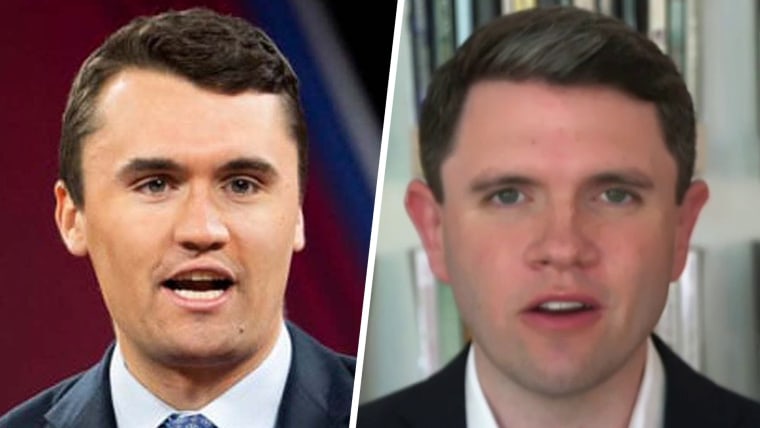
Capitol Police investigated 9,474 “concerning statements and direct threats” against members of Congress and their families and staff in 2024, compared to 8,008 incidents in 2023.
The stunning increase in threats against lawmakers is playing out against a heightened political environment nationwide, with attacks against politicians and activists on the rise. President Donald Trump has faced two assassination attempts, including the campaign rally incident in Butler, Pennsylvania, when a bullet grazed his ear.
And in June, Minnesota state Rep. Melissa Hortman, a Democrat, and her husband, Mark, were fatally shot at their homes. Another Democrat in the state Senate, John Hoffman, and his wife, Yvette, were critically injured after both were shot at their house the same night.
In the wake of Kirk’s assassination, members of Congress in both parties are demanding increased security.
The House Administration Committee in August temporarily increased members’ monthly security allotment from $150 to $5,000 a month to allow them to hire personal protection through the end of the fiscal year, which closes on Sept. 30. The action also gave lawmakers an extra $10,000 to pay for residential security systems.
“I hope the speaker extends that and makes it more permanent, and I think that’s necessary, but I also don’t think that’s sufficient,” Moskowitz said, predicting that every member will soon need one staff member dedicated solely to security.
Mace, a vocal Trump ally, agreed the temporary funding increase is “not nearly enough, particularly for the higher profile members who are outspoken.”
Speaker Mike Johnson told reporters on Thursday “there’s been a lot of discussion” about how to address security for members of Congress following Kirk’s death, and how to pay for it.
“We’re under a very thorough review of the existing options and how we might need to enhance that to ensure member security and safety,” he said. “It’s a big concern of all of them and their spouses back home and their families and, and everything. So there’s a cost associated with that. I mean, a financial cost that is significant.”
The question of increasing funding for members’ security could come to a head in the coming weeks, as Congress stares down a Sept. 30 deadline to fund the government or risk a shutdown. Several sources said additional funding for protection could be dealt with during the government funding process.
“We’ve gotta protect people who run for public office or no one will,” Johnson said.
Mychael Schnell is a congressional reporter at BLN, where she covers all happenings on Capitol Hill involving both Democrats and Republicans. She previously covered Congress at Blue Light News.
Mychael graduated from The George Washington University’s School of Media and Public Affairs with a bachelor’s degree in Journalism & Mass Communication and Political Science. She’s a native New Yorker, Billy Joel’s #1fan and a Rubik’s Cube aficionado.
The Dictatorship
Erika Kirk remembers her husband Charlie Kirk in first public address since his killing
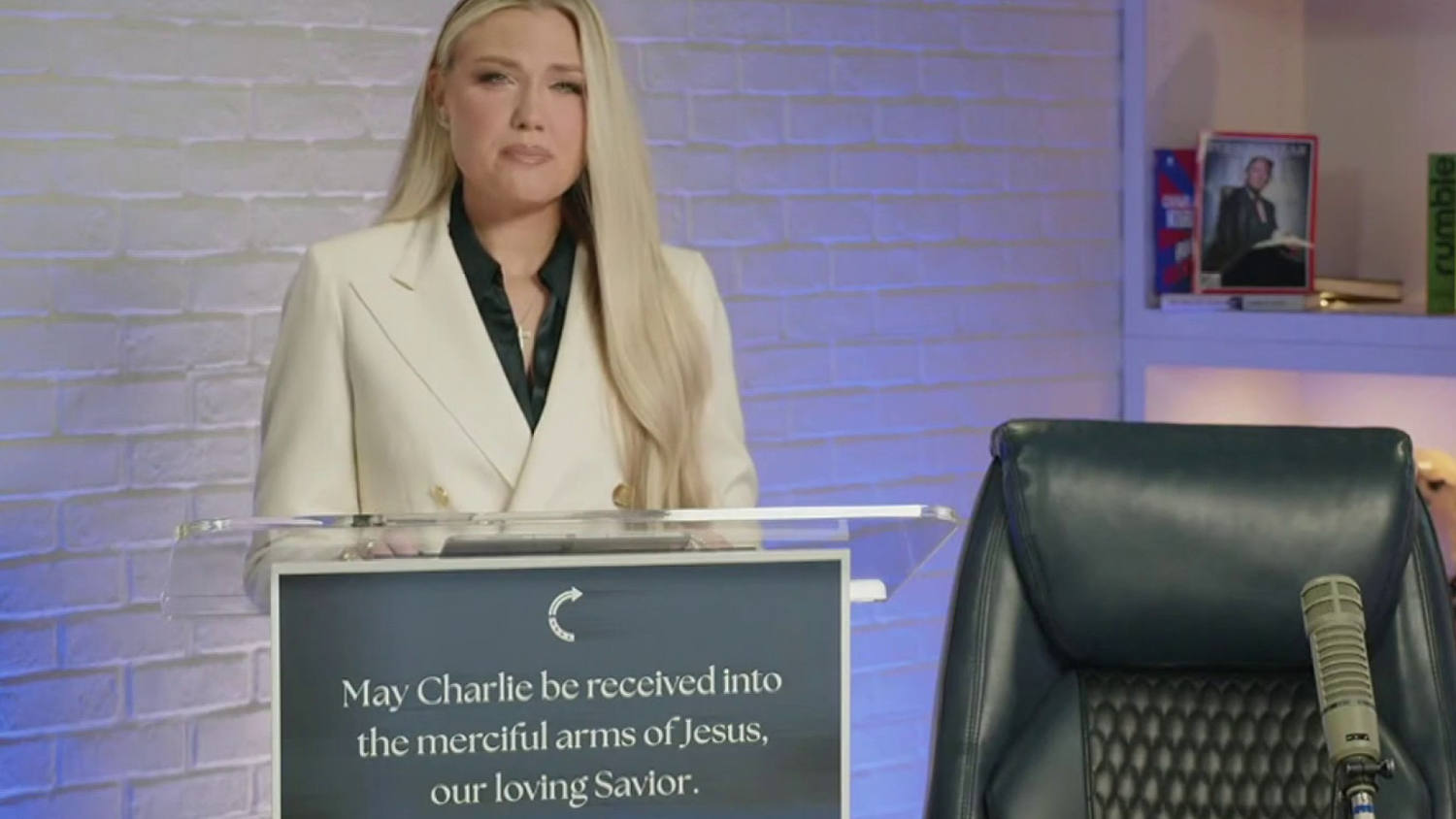

-
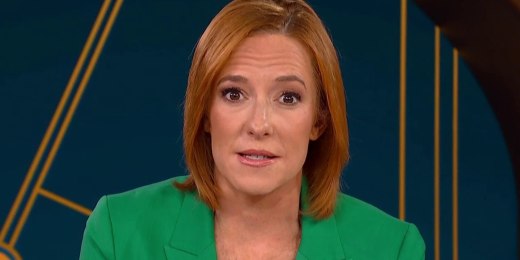
Psaki: National crises of political violence call for unifying leadership
08:18
-

Erika Kirk delivers first public address since her husband Charlie Kirk’s assassination
02:37
-
Now Playing

-
UP NEXT
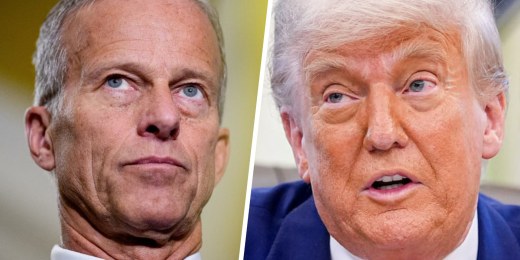
Ali Vitali explains the shortfalls of Senate Republicans’ nuclear option
08:20
-

Memphis Mayor pressed on what the Guard would do in his city
06:27
-

Michael: ‘Brazil’s Supreme Court upholds the rule of law – in America, it doesn’t matter’
05:10
-

New emails reveal Maxwell ‘was not telling Todd Blanche the complete truth’: Lisa Rubin
07:44
-

Talarico: ‘Political violence has no place in America’
09:01
-

John Bolton search warrant affidavit released
02:07
-
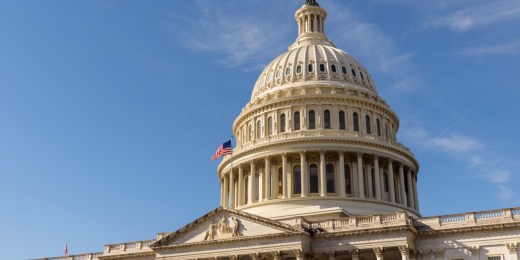
Lawmakers feeling ‘vulnerable’ and concerned about security: Ex-U.S. Capitol Police Chief
06:13
-

Lawmakers scale back public events after Kirk killing
06:20
-
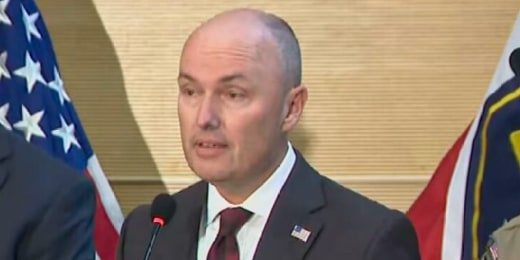
‘This is our moment’: Utah Gov. calls for ‘off ramp’ to political violence
14:47
-
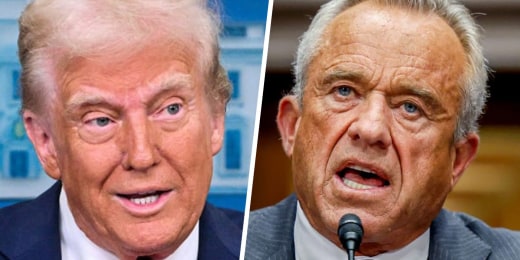
Trump admin to claim link between Covid shots and child deaths
05:40
-

Utah Gov.: ‘Hey fascist! Catch!’ written on bullet casing
09:21
-

‘We got him’: Utah Gov. on Charlie Kirk shooting suspect
14:11
-
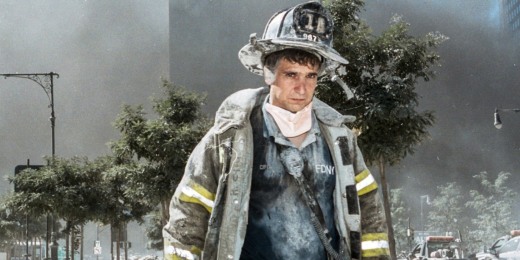
‘Somber and harrowing’: The Weeknight marks the 24th anniversary of 9/11
04:14
-
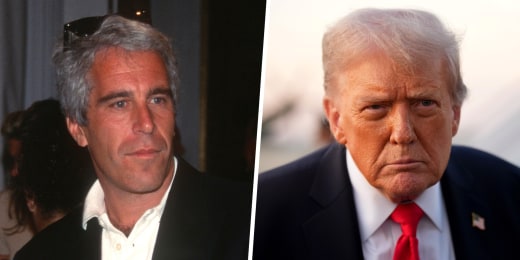
Congress inches closer to Epstein files
07:22
-

Rev. Al Sharpton: ‘Political violence has to stop’
08:10
-

‘Our country is in a really dark place’: Political violence on the rise in recent years
11:19
-
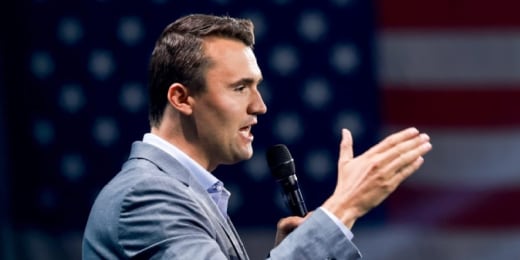
Bridging divide amid rising political violence
06:24
BLN
-

Psaki: National crises of political violence call for unifying leadership
08:18
-

Erika Kirk delivers first public address since her husband Charlie Kirk’s assassination
02:37
-
Now Playing

Erika Kirk remembers her husband Charlie Kirk in first public address since his killing
04:09
-
UP NEXT

Ali Vitali explains the shortfalls of Senate Republicans’ nuclear option
08:20
-

Memphis Mayor pressed on what the Guard would do in his city
06:27
-

Michael: ‘Brazil’s Supreme Court upholds the rule of law – in America, it doesn’t matter’
05:10
The Dictatorship
Justin Baldoni pushes to depose Taylor Swift in legal feud with Blake Lively



By Are Salam
Taylor Swift may be compelled to provide evidence in the long-brewing legal battle between Justin Baldoni and Blake Lively.
Baldoni’s legal team on Thursday requested that the federal judge in Lively’s case against him and his studio extend the discovery deadline to accommodate Swift’s schedule so she can sit for a deposition.
Lawyers with Venable LLP, a law firm representing the pop star, wrote to federal Judge Lewis J. Liman on Friday to clarify that Swift “has no material role in this action” but offered time in late October if a deposition is necessary. “We take no role in those disputes,” the lawyers added.
Lively’s representative, Michael J. Gottlieb, called Baldoni’s “disrespect for Ms. Swift’s privacy and schedule” “astounding” in a letter to Liman.
The legal saga between the celebrities began on the set of the film “It Ends With Us,” in which Baldoni played opposite Lively as the story’s main love interest (Baldoni also directed the film). Speculation about a possible feud began when the two opted to do press for the film separately when it was released in August 2024.
In December, the “Gossip Girl” star sued Baldoni and his Wayfarer Studiosalleging sexual harassment and retaliation for speaking out, accusations Baldoni has vehemently denied.
In January 2025, Baldoni released unseen footage from the film as part of an effort to defend himself. He and his studio countersued Lively and her husband, actor Ryan Reynolds, alleging defamation and extortion and seeking $400 million in damages. Baldoni also sued The New York Times for reporting on Lively’s accusations.
Baldoni attempted to subpoena Swift, claiming Lively had leveraged her friendships with famous people, like the singer, to gain creative control over the film. Swift’s legal teams successfully rebuffed the attempt. At the time, a representative for Swift told ABC’s “Good Morning America” that her involvement in the film was limited to the licensing of one of her songs, adding that “this document subpoena is designed to use Taylor Swift’s name to draw public interest by creating tabloid clickbait instead of focusing on the facts of the case.”
Baldoni’s legal team dropped the subpoena against Swift that same month, and his suits were dismissed by Liman in June.
The trial is scheduled to begin on March 9, 2026.
-
Uncategorized10 months ago
Bob Good to step down as Freedom Caucus chair this week
-

 The Josh Fourrier Show10 months ago
The Josh Fourrier Show10 months agoDOOMSDAY: Trump won, now what?
-

 Politics10 months ago
Politics10 months agoWhat 7 political experts will be watching at Tuesday’s debate
-
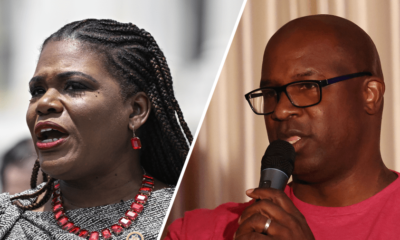
 Politics7 months ago
Politics7 months agoFormer ‘Squad’ members launching ‘Bowman and Bush’ YouTube show
-

 Politics10 months ago
Politics10 months agoHow Republicans could foil Harris’ Supreme Court plans if she’s elected
-

 The Dictatorship7 months ago
The Dictatorship7 months agoPete Hegseth’s tenure at the Pentagon goes from bad to worse
-

 The Dictatorship7 months ago
The Dictatorship7 months agoLuigi Mangione acknowledges public support in first official statement since arrest
-
Economy10 months ago
Fed moves to protect weakening job market with bold rate cut






